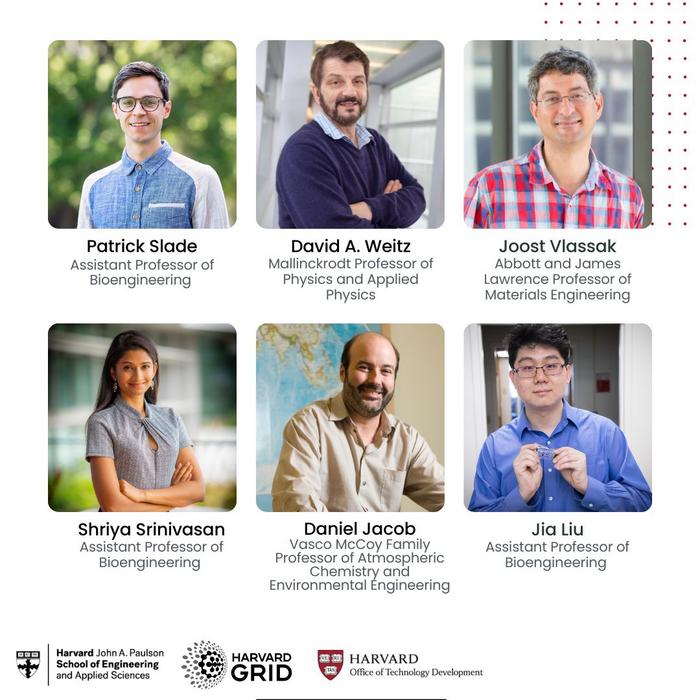The Harvard Grid Accelerator announced awards to six interdisciplinary projects that have transformative potential in health, climate, and manufacturing. The Grid Accelerator identifies and supports the ‘de-risking’ of high-potential Harvard science and engineering lab-based projects with the goal of translating them into startups or other commercialization opportunities within a year.

Credit: Harvard SEAS
The Harvard Grid Accelerator announced awards to six interdisciplinary projects that have transformative potential in health, climate, and manufacturing. The Grid Accelerator identifies and supports the ‘de-risking’ of high-potential Harvard science and engineering lab-based projects with the goal of translating them into startups or other commercialization opportunities within a year.
Harvard Grid is a collaboration between Harvard’s Office of Technology Development (OTD) and the John A. Paulson School of Engineering and Applied Sciences (SEAS). The Grid partners with Harvard science and engineering researchers to help shape and advance their research from labs to markets for impact.
“Research teams embarking on groundbreaking projects often find themselves at a critical juncture—the transition from visionary concepts to tangible commercial applications,” Isaac Kohlberg, Senior Associate Provost and Chief Technology Development Officer at Harvard University. “Grid Accelerator funding and mentoring ensure that these transformative projects reach their full potential to address global challenges.”
“The Grid Accelerator brings critical elements to bear to take science from our labs out into the world to drive positive change and improve lives,” said David C. Parkes, John A. Paulson Dean and George F. Colony Professor of Computer Science at SEAS. “The projects funded by the Grid Accelerator awards are notable examples of the cross-disciplinary research conducted at SEAS.”
The six teams of Harvard researchers receiving the 2024 Harvard Grid Accelerator awards are:
- Methane Emissions Analytics: Leveraging satellite observations to measure and geospatially map methane emissions.
- Advanced Drug Delivery and Encapsulation: Developing asymmetric polysaccharide-coated lipid vesicles for improved drug delivery.
- AI-Driven Flexible Bioelectronics: Creating AI-driven flexible therapeutic solutions.
- Wearable Spasticity Management & Mitigation: Helping patients recover improved motility control and coordination.
- Navigation Aid for the Visually Impaired: Enabling visually impaired persons to navigate urban settings with independence and confidence.
- Non-Motorized Levitating Devices for Upper Atmosphere Sensing and Communication: Discovering climate data, communications pathways, and defense capabilities.
The Grid Accelerator builds upon a proven track record of the OTD Physical Sciences and Engineering Accelerator. Since 2013, projects advanced by Grid/OTD Accelerator support have culminated in 17 launched startups that have collectively raised $176 million, as well as technology licenses to established companies and sponsored research agreements.
“From a cast of several exciting possibilities, these six projects have a line-of-sight to launch, in some form, in about a year and impressed the selection committee with their potential to meaningfully elevate the human condition on a global scale,” Paul Hayre, Executive Director of the Harvard Grid, commented on the selection. “Our role now shifts from selection to support to see that they achieve their objectives.”
In addition to funding, the awardees gain access to educational programs and networks of industry, venture, product development, and investment experts.
For more information on these six projects and more, visit grid.harvard.edu.
Extended project descriptions:
Methane Emissions Analytics
Problem: There is growing demand from climate policy stakeholders to use satellite observations of greenhouse gases to quantify emissions.
Proposed Solution: A research team led by Daniel Jacob, Vasco McCoy Family Professor of Atmospheric Chemistry and Environmental Engineering and leader of the Atmospheric Chemistry Modeling Group at SEAS, is developing an Integrated Methane Inversion (IMI) cloud-based, open-source software tool. This tool leverages inverse methods to infer methane emissions from satellite data, enabling stakeholders to estimate emissions with high resolution for their domains and periods of interest, including continuous monitoring. The project will focus on the development of a Software as a Service (SaaS), automated reports and alerts, and the development of support and training materials.
Advanced Drug Delivery and Encapsulation
Problem: Current strategies to encapsulate drugs do not allow for the encapsulation of proteins and can lack tunability and cause low cellular uptake.
Proposed Solution: A research team led by David A. Weitz, Mallinckrodt Professor of Physics and Applied Physics at SEAS, proposes to engineer asymmetric polysaccharide-coated lipid vesicles to broaden the parameter space for engineering the mechanical and biochemical properties of lipid vesicles. If able to encapsulate and deliver any nucleic acid, protein, or small molecule into drug delivery vehicles, new treatment methods for gene and cancer therapy are possible. The team will use an inverted emulsion technique to form lipid vesicles with distinct leaflets, where each leaflet can be individually configured and modified. Additionally, they will functionalize the lipid vesicles with polysaccharides to enable cell-specific targeting. This will reduce the cost and side effects compared to current drug delivery vehicles and might lead to a completely new generation of vaccine technology and disease treatment.
AI-Driven Flexible Bioelectronics
Problem: The mismatch between traditional rigid electronics and the soft, dynamic nature of the human body limits the seamless integration of high-performance sensors, stimulators, and computational units with the human body.
Proposed Solution: A research team led by Jia Liu, Assistant Professor of Bioengineering at SEAS, is developing technology that converges flexible nanoelectronics, advanced surgical techniques, and sophisticated AI agents to create bioelectronic interfaces that can be precisely deployed for tissue modulation across various organs. These interfaces are designed for long-term stability and high-resolution recording and control, targeting specific tissue regions with minimized cross-stimulation for the treatment of conditions such as neurological disorders, cancers, and diabetes.
Wearable Spasticity Management and Mitigation
Problem: Spasticity causes involuntary muscle stiffness and contractions in over 12 million individuals worldwide, and is accompanied by a debilitating hindrance to movement, lack of independence, and chronic pain.
Proposed Solution: A research team led by Shriya Srinivasan, Assistant Professor of Bioengineering at SEAS, is developing a wearable stimulation system incorporating critical parameter optimization and user connectivity components necessary for large-scale clinical trials in patients with spasticity. Current approaches are invasive and bulky with modest to low efficacy. The research team aims to develop the Wearable Adaptive Vibrotactile Bracelet (WAVelet), a cost-effective and low-risk alternative.
Navigation Aid for the Visually Impaired
Problem: Existing navigation solutions for the more than 400 million people around the world who have impaired vision ranging from moderate impairment to blindness only partially address the navigation challenges identified by users.
Proposed Solution: A research team led by Patrick Slade, Assistant Professor of Bioengineering and leader of the Harvard Ability Lab at SEAS, developed a navigation system that combines novel computer vision techniques, sensor fusion, and personalized feedback to the user, requiring only a smartphone. The technology will provide the functionality of guide dogs at approximately 20 times lower cost, within the price range specified by the surveyed users, creating the potential to dramatically increase the number of people who can benefit from navigation assistance. Additionally, the technology adds essential independent navigation capabilities to help people travel to new destinations and provide environmental scene understanding.
Non-Motorized Levitating Devices for Upper Atmosphere Sensing and Communication
Problem: The mesosphere is an inaccessible region of the atmosphere (50-100 km altitudes) that is too high for conventional aircraft to generate lift, yet too low for satellites to maintain orbit. Flight in this near-space region would unlock a trove of climate data, communications pathways, and defense capabilities that no current hardware can achieve.
Proposed Solution: A research team led by Joost Vlassak, Abbott and James Lawrence Professor of Materials Engineering at SEAS, is developing an entirely new propulsion mechanism to enable mesospheric flight. The technology uses sunlight-induced thermal gradients to generate photophoretic forces, which propels lightweight devices upward without onboard power or fuel. The team previously modeled that a photophoretic force, thermal transpiration, could lift 100 mg-scale payloads onboard a 10 cm-wide device at an altitude of 70 km. They now aim to demonstrate that the devices can hold a variety of payloads and communicate while flying.
About Harvard University’s Office of Technology Development
Harvard’s Office of Technology Development (OTD) promotes the public good by fostering innovation and translating new inventions made at Harvard University into useful products that are available and beneficial to society. Our integrated approach to technology development comprises sponsored research and corporate alliances, intellectual property management, and technology commercialization through venture creation and licensing. More than 100 startups have launched to commercialize Harvard technologies in the past 5 years. To further bridge the academic-industry development gap, Harvard OTD manages the Blavatnik Biomedical Accelerator and jointly oversees the Harvard Grid and the Climate and Sustainability Translational Fund. For more information, please visit https://otd.harvard.edu.
About The Harvard John A. Paulson School of Engineering and Applied Sciences
The Harvard John A. Paulson School of Engineering and Applied Sciences serves as the connector and integrator of Harvard’s teaching and research efforts in engineering, applied sciences, and technology. Through collaboration with researchers from all parts of Harvard, other universities, and corporate and foundational partners, we bring discovery and innovation directly to bear on improving human life and society.




